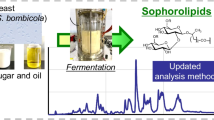Abstract
The influence on fatty acid composition of growth medium composition and phase of growth during batch culture and of dilution rate and growth temperature during continuous culture was studied in the eicosapentaenoic-acid (20:5 n-3)-producing Vibrio CCUG 35308. In glucose-mineral medium, even-numbered normal fatty acyl residues, primarily 16:0, 16:1, 18:1, and 20:5, strongly dominated (ca. 90%), and the fatty acid profile remained practically unchanged throughout a batch-growth cycle. In nutrient broth, the contribution by “uncommon” fatty acids, mainly i-13:0, 15:0, i-15:0, and 17:1 was generally higher, and increased from 15.4% of total fatty acids in early exponential growth phase to 33.2% in the stationary phase. Reduction of the dilution rate in a chemostat from 0.27 to 0.065 h–1 also led to an almost threefold increase in the proportion of odd-numbered residues at the expense of the even-numbered normal ones. Contrary to this plasticity in the overall fatty acid profile influenced by variations in nutrient composition and availability, the level of eicosapentaenoic acid seemed exclusively dictated by growth temperature. The synthesis of this polyunsaturated fatty acid may be a key regulatory process in maintaining membrane fluidity.
Similar content being viewed by others
Author information
Authors and Affiliations
Additional information
Received: 3 November 1995 / Accepted: 25 February 1996
Rights and permissions
About this article
Cite this article
Jøstensen, JP., Landfald, B. Influence of growth conditions on fatty acid composition of a polyunsaturated-fatty-acid-producing Vibrio species. Arch Microbiol 165, 306–310 (1996). https://doi.org/10.1007/s002030050331
Issue Date:
DOI: https://doi.org/10.1007/s002030050331




